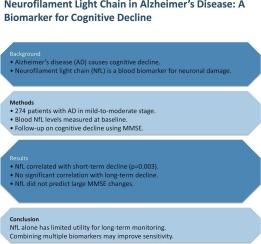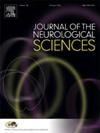Serum neurofilament light chain levels are associated with cognitive decline in a consecutive cohort of patients with Alzheimer's disease.
IF 3.2
3区 医学
Q1 CLINICAL NEUROLOGY
引用次数: 0
Abstract
Background
Alzheimer's disease (AD) is characterized by cognitive decline, but the individual progression rates vary. One type of blood-based biomarker that has been widely investigated is neurofilament light chain (NfL), as it reflects measures neuronal damage.
Aim
The aim of the current study was to investigate whether NfL could determine the rate of progression in patients with AD.
Methods
A total of 274 patients with dementia due to AD in the mild to moderate stage were included in the study, during the initial diagnostic evaluation at a memory clinic. At the initial evaluation, blood samples were collected, and the serum was analyzed for NfL. Follow-up by a clinician was performed in accordance with the workflow in the clinic.
Results
A significant negative association was found between short-term progression (days, mean (SD): 365 ± 224) and NfL (estimate (log-transformed): −1.2792, p-value: 0.003). No significant association was found between long-term progression (days, mean (SD): 611 (323) and NfL. NfL could not separate whether a patient was going to progress more than two points on the Mini-Mental Status Examination (MMSE) between the baseline visit and the first follow-up.
Conclusions
Although serum levels of NfL were associated with changes in MMSE, they do not alone provide sufficient utility for long term monitoring of cognitive decline in patients with AD. To achieve the desired sensitivity for this purpose, a combination of blood-based biomarkers, validated in clinical cohorts, may be necessary.
Significance statement
This study suggests that serum levels of neurofilament light chain cannot predict cognitive decline in individual patients with Alzheimer's Disease.

在一组阿尔茨海默病患者中,血清神经丝轻链水平与认知能力下降有关
阿尔茨海默病(AD)的特点是认知能力下降,但个体进展率各不相同。一种基于血液的生物标志物被广泛研究是神经丝轻链(NfL),因为它反映了神经元损伤的测量。本研究的目的是探讨NfL是否可以决定AD患者的进展速度。方法在记忆门诊进行初步诊断评估时,共纳入274例轻度至中度阿尔茨海默病痴呆患者。在初步评估时,采集血样,分析血清中是否存在NfL。临床医生按照临床工作流程进行随访。结果短期进展(days, mean (SD): 365±224)与NfL (estimate (log-transformed):−1.2792,p值:0.003)呈显著负相关。长期进展(天,平均(SD): 611(323))与NfL之间未发现显著关联。NfL无法区分患者在基线访问和第一次随访之间是否会在迷你精神状态检查(MMSE)中取得超过两分的进展。结论:尽管血清NfL水平与MMSE的变化相关,但它们并不能单独为AD患者认知能力下降的长期监测提供足够的效用。为了达到这一目的所需的灵敏度,可能需要在临床队列中验证的基于血液的生物标志物的组合。本研究提示血清神经丝轻链水平不能预测阿尔茨海默病患者个体的认知能力下降。
本文章由计算机程序翻译,如有差异,请以英文原文为准。
求助全文
约1分钟内获得全文
求助全文
来源期刊

Journal of the Neurological Sciences
医学-临床神经学
CiteScore
7.60
自引率
2.30%
发文量
313
审稿时长
22 days
期刊介绍:
The Journal of the Neurological Sciences provides a medium for the prompt publication of original articles in neurology and neuroscience from around the world. JNS places special emphasis on articles that: 1) provide guidance to clinicians around the world (Best Practices, Global Neurology); 2) report cutting-edge science related to neurology (Basic and Translational Sciences); 3) educate readers about relevant and practical clinical outcomes in neurology (Outcomes Research); and 4) summarize or editorialize the current state of the literature (Reviews, Commentaries, and Editorials).
JNS accepts most types of manuscripts for consideration including original research papers, short communications, reviews, book reviews, letters to the Editor, opinions and editorials. Topics considered will be from neurology-related fields that are of interest to practicing physicians around the world. Examples include neuromuscular diseases, demyelination, atrophies, dementia, neoplasms, infections, epilepsies, disturbances of consciousness, stroke and cerebral circulation, growth and development, plasticity and intermediary metabolism.
 求助内容:
求助内容: 应助结果提醒方式:
应助结果提醒方式:


